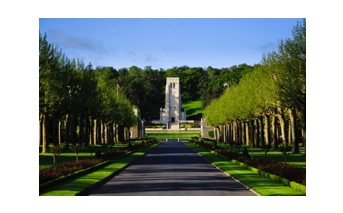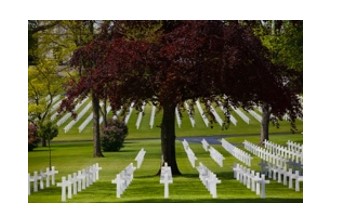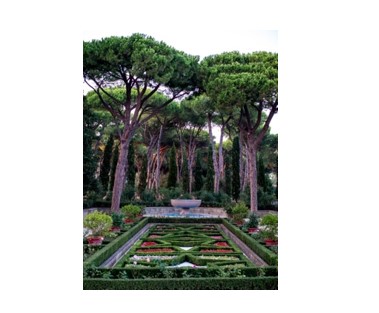Trees of the American Battle Monuments Commission
One of the hallmarks of an American Battle Monuments Commission (ABMC) site is the precise landscape design that contributes to a respectful and reflective atmosphere. Not only was the cemetery, monument or memorial layout carefully selected and the architecture meticulously planned, but the surrounding flora was also thoughtfully chosen as a part of each construction project.
“Trees are a major component of our sites,” said Charlie Sommer, a horticultural technician with ABMC.
Broken down, each site’s distinct planting plan groups trees into one of three categories: alignment, specimen, and woodland. Regardless of category, the trees at ABMC play an important role in shaping a visitor’s overall experience at the site.
“Alignment trees are the backbone that structures the sites and directs the visitor's view, said Sommer. “Specimen trees draw attention to particular spaces, and the woodland areas that surround our sites are there to create a soothing atmosphere, isolated from the outside world and conducive to meditation or reflection.”
Used in this complementary way, the trees effectively act as a framing mechanism or a visual “look no further,” noted Doug Meney, ABMC’s director of horticulture.
“Densely wooded areas can create a visual and physical barrier, while sparsely planted waves of trees can lead the eye into thinking the site is larger than it is. Waves of trees can also lead the visitor to think that there is something else behind that wave,” said Meney, all depending on what effect the landscape architect was trying to achieve.
Aisne-Marne American Cemetery—a World War I (WWI) site that is structured along a strict architectural design which harkens back to French garden influences—is a ready example of this harmonious application. The site employs pin-straight rows of oriental plane trees (Platanus Orientalis) along the main entry to draw the eye directly to the towering chapel. Clumps of woodland trees meander behind the white headstones, creating a softened visual barrier between the lawn and the denser forest beyond. And scattered throughout the plots are standalone specimen trees—a saucer magnolia for example (Magnolia × Soulangeana).
According to Sommer, while WWI cemeteries incorporate more precise structure, World War II (WWII) cemeteries instead follow a design with less alignment and more isolated trees—a style more closely influenced by English garden designs.
While there is some flexibility in incorporating new varieties, particularly among the more densely woven woodlands, the ABMC’s site-unique planting plans are more likely to specify the exact specimen of trees to be used—something that can become challenging given the impacts of disease or climate change.
“At Brittany American Cemetery, we changed the alignment trees to another genus completely, but before we [made] this decision we spent a number of years researching the possible alternatives within the original genus,” said Meney.
Though lengthy and deliberate, this process allows ABMC’s horticultural experts to make their decisions based on scientific reasoning rather than subjective preferences when trees need to be replaced. It also tends to cultivate better outcomes for the trees and allows the original intent of the planting plan to shine through.
Picking a favorite among the many species growing at ABMC sites is “akin to picking your favorite child” according to Meney, who nonetheless admits an affinity for what he calls “the majestic charm” of a mature purple beech tree (Fagus Sylvatica Atropurpurea), which can be seen at Henri-Chapelle American Cemetery, and the Sweetgum tree (Liquidambar Styraciflua) at Brittany American Cemetery.
For his part, Sommer agrees.
“Each tree has its own charm when planted in the right context, and it is up to us to adapt to find the best compromise,” he said. “Each tree can be extraordinary if we let it express itself in the best way.”
Remarkable trees
The likely oldest tree at an ABMC site is the oriental plane tree (Platanus Orientalis) at the Lafayette Escadrille Memorial Cemetery in France, which is believed to have been planted in the 18th century and is recognized as one of the largest trees in the Hauts-de-Seine department. It was designated by L’Association ARBRES—the French association for trees—as one of several hundred “remarkable” trees in the country on July 16, 2019. The group bestows this honor on trees based not on beauty, but on age, size and history.
A tulip tree (Liriodendron Tulipifera), also at the Lafayette Escadrille Memorial Cemetery, has likewise been officially registered as a “Remarkable Tree” by L’Association ARBRES.
“Veteran” trees
Additionally, a common beech tree (Fagus Sylvatica) rests at the foot of the Montfaucon American Monument in France. It is believed the tree was already growing at the time of the Meuse-Argonne Offensive between September and November of 1918.
There are also a few “veteran” oak trees left in Belleau Wood, abutting the Aisne-Marne American Cemetery in France. Though the woods were devastated by the battle that took place there in June 1918, these oak trees have withstood time and now surround the Marine Monument along the Belleau Wood Trail.
Trees in trouble
While ABMC’s horticultural experts spend a great deal of time and effort caring for the agency’s trees throughout the world, the health of the plants is not always guaranteed and even some of the most majestic specimens can be impacted.
According to Sommer, this includes a blue cedar (Cedrus Atlantica 'Glauca') at Somme American Cemetery, which has been affected by a root fungus; a common purple beech (Fagus Sylvatica Purpurea) also at Somme American Cemetery and impacted by a root fungus; several common beech trees (Fagus Sylvatica) in the wooded areas at Luxembourg American Cemetery, which are dying out due to climate change; and several alignment trees at Florence American Cemetery that required replacement due to a fungus that was killing the originals.
To this end, the ABMC horticultural team has worked to implement a number of environmentally-friendly, green solutions to address plant health. In some instances, this means things like alternative methods of pest control and reduced reliance on chemicals in favor of more natural approaches. In other cases, it is a matter of trial and error—backed by a great deal of research and experience—to keep the trees in prime shape.
“Our crews work exceptionally hard to maintain the health of our living commemorative fixtures at these sites—the lawns, plants and trees,” said Meney. “No detail goes overlooked because every element that makes up our cemeteries works collectively to serve the greater mission—to honor those who laid down their lives. “




